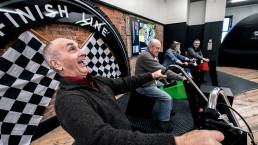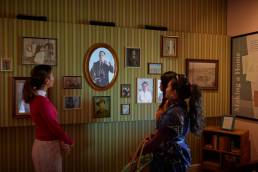Visitor experience design is focused on delivering a narrative to an audience.
We’re known for using technology to support storytelling… continuing a human tradition that goes back thousands, maybe millions, of years. There is no mystery in the application of technology to storytelling, which is as old as storytelling itself.
There are examples around the globe, and across time: ancient Egyptian puppetry and Indonesian shadow theatre transform inanimate objects into characters with lives of their own; Western theatre’s scenography, trapdoors, smoke and mirrors, and all manner of contraptions raised and lowered by block and tackle. Even oil paints are technology.
Performers and artists have always vigorously co-opted technology in the pursuit of novel ways of entertaining and informing their audiences.

A rippin' good time at Motorcycle Mecca in Invercargill
The challenge today is the same as in the past – to surprise and delight our audiences.
Technology is employed to cultivate playful engagement between written, material, spatial, and auditory elements of a story, and audience members. Too often technology overshadows the narrative, becoming a distraction and an end in itself. We work hard to make sure that doesn’t happen.
Technology offers numerous opportunities for audiences to experience stories in novel ways. But “novel” doesn’t just mean “new.” It implies something out of the ordinary. While it might be new or repurposed, it shouldn’t feel commonplace. Even familiar technologies can achieve novelty through unexpected or surprising relationships.
At Motorcycle Mecca visitors can sit on one of 6 different mock motorcycle and rev a simulated engine to create the sound of some famous bikes. You can see this in the short video below of our prototype, and in the image of the final bike in situ in Invercargill.
Likewise, there is an opportunity to provide a spatial experience that a visitor wouldn’t ordinarily encounter. For instance, visitors typically don’t encounter large-scale human-sized immersive experiences at home. Or the chance to touch something “weird” in a safe way.


A classic of this is our project Our Space for New Zealand’s National Museum Te Papa. This interactive, large size map of Aotearoa New Zealand attracted people from around the country and the world to explore our country in new and intriguing ways, on a large scale.
Combining two or more familiar techniques in a surprising way can provide the magic we, our clients and our visitors are looking for.
At Cape Leeuwin Lightkeeper’s Cottage, we combined stills and video with infrared triggers so that when you approach wall-hung photos, they come alive and tell you a story.